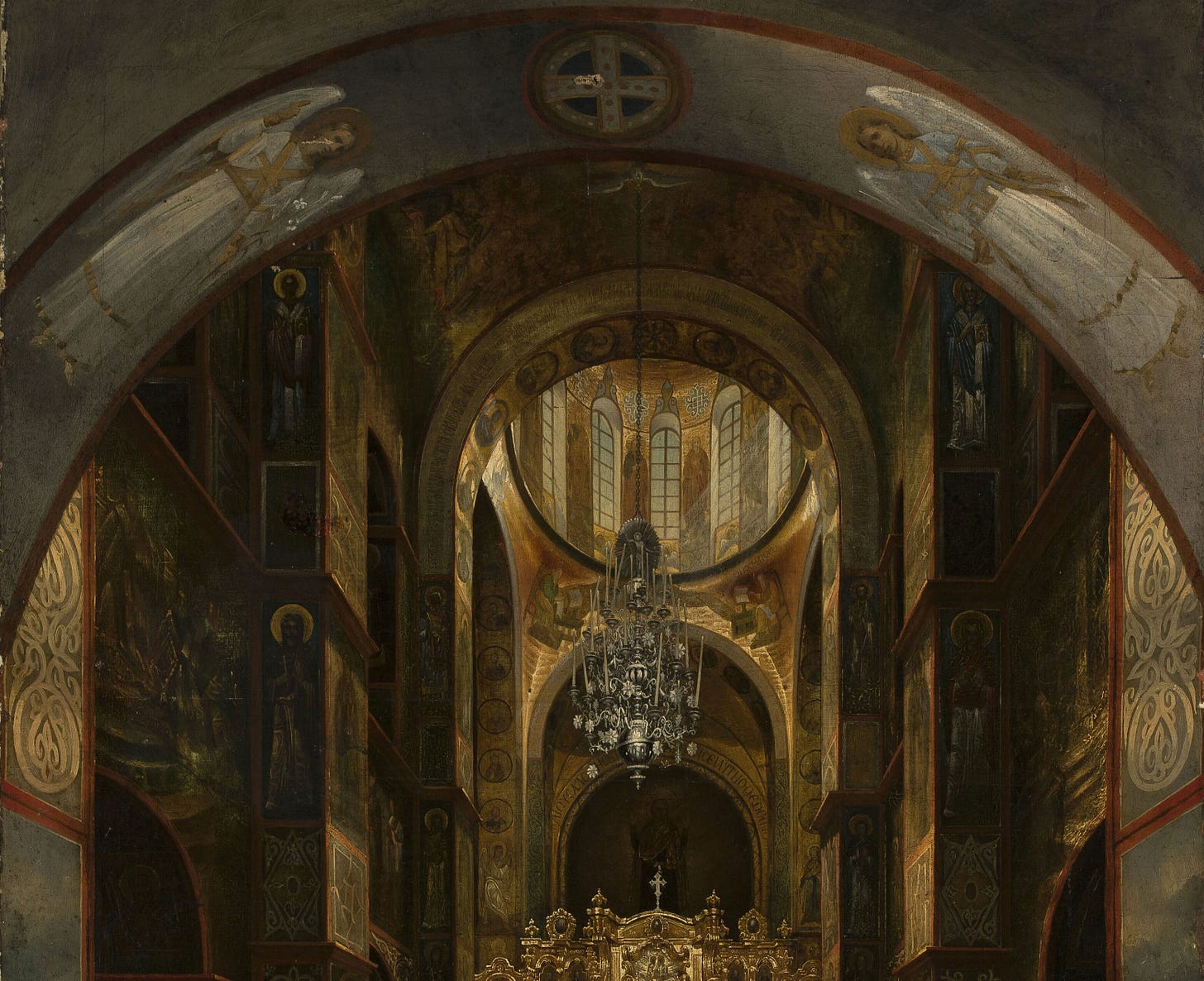This Weekly Edition of Inkwell features September Santiago
IT WAS AUGUST OF 2023, two years before the phone call. I had never stepped foot inside a church building that wasn’t of the modern megachurch variety; never experienced the liturgy of history baked into the Catholic and Orthodox expressions, and so I anxiously watched the parishioners around me to guide my actions. Between the foreignness of the Latin language and my sensitivity to new experiences, I left the service deeply unsettled, with the feeling persisting during a lunch with my friend who had invited me. I found myself floundering on a sea I hadn’t even realized I was sailing through. A void, previously unnoticed, seemed to gape wider. What was this world, existing for thousands of years before the contemporary version of the faith I had always known growing up?
I LINGERED ON the sun-soaked front porch, bathing in a rare beam of warm light as the winter ended, chirruping birds flitted from tree to tree, an unwitting audience to a phone call with my childhood friend. My eyes were closed, a dull red colored my lids. “If I could sum up Orthodoxy in one word, it would be Love,” she says—the intonation presumed a capital L. I smiled, an expression she couldn’t have seen from where she sat in her own West Coast home thousands of miles away. Her words rang with a quiet vibrancy.
Clive Staples Lewis once remarked in a letter, “We may ignore, but we can nowhere evade, the presence of God. The world is crowded with Him. He walks everywhere incognito. And the incognito is not always hard to penetrate. The real labour is to remember, to attend. In fact, to come awake. Still more, to remain awake.” The man was onto something.
At the luncheon after my first experience of a Latin liturgy, my friend invited me to accompany her to Germany, and I figured I couldn’t say no to my first experience of Europe—I could feel it in my bones that this trip might be some kind of personal catalyst, or cataclysm.
GERMANY BEARS A HISTORY deeper and more layered than anything I’d experienced in my day-to-day life as a twenty-something in the United States of America. Augsburg had been modernized in some ways, of course, but its towering edifices, clock towers, weathered statues, and sense of grit and gravitas haunted me. I could feel an archaic, austere, noble presence following through streets and hidden alleys, whispering secrets of the past. Here was a city old enough to know.
In the quiet corners of Dom Mariä Heimsuchung, better known as Augsburg Cathedral, we found shrines dedicated to various religious figures. Christus mansionem benedicat—"May Christ bless this house"—adorned doorways. Stone figures of Christ, the Virgin Mary, saints standing sentinel in courtyards or nestled against older dwellings, unwavering in their silent testimony. The medieval Gothic tradition also bore hints of sublime Romanesque elements and traces of baroque embellishment. Standing beneath the central glass window depicting Mary’s visitation, I felt dwarfed by the grandeur. The weight of history felt like a hydraulic press exerting its force upon my West Coast mind.
Despite my not being able to locate myself in the history of what I was experiencing, it didn’t matter at that moment—each sight overwhelmed me, humming with inexplicable purpose. Tears gathered behind my eyelids as the unsettling presence I first encountered at the invitation of my friend returned. A question hovered on my lips. God, where are you in all of this grandeur? I’m not used to this vastness. Are you revealing something to me? Show yourself! It was an uncharacteristic demand that emerged from my depths.
ONE NIGHT, we found ourselves in the kitchen of the rental apartment, the window thrown open to the fresh August breeze—a welcome contrast to the muggy heat of my hometown. The night sky, glittering with stars, stretched endlessly as we leaned out the window, enraptured by the quiet hum of a city winding down. A stillness settled over me, a contemplative calm. After we had both said goodnight, I sat on the window casing of my bedroom, looking out through a screenless opening to a park across the street. I had a Bible open on my lap, frantically reading passage after passage, trying to understand the verses which I’d always thought meant something certain, but to my now confused mind, could perhaps mean all sorts of things.
Among the gothic depictions of religious figures I had seen that day, I noted the recurring motif of death—embossed in bas-reliefs, etched into walls, captured in paintings, and, of course, enshrined in the crypt. Along one wall, a carved relief bore the shepherd’s rod and a pope’s headdress. Beneath them, an alabaster skull grinned, a white shroud intact. A powerful leader trampling Hades itself with the might of the Shepherd’s staff.
Having grown up firmly evangelical in a distinctly American church setting, I was both intrigued and unsettled. The hope of Christendom lies in the salvation of the soul, the glorious adventure of eternity. Yes, death was conquered at the cross, but why dwell on it? A darkness persisted in this space haunted by Heaven. Somewhere within the cathedral lay the tombs of nobleman Konrad Hirn and his wife Afra, not to mention the surviving catacombs. Did the architects and artists of the Augsburg Cathedral not fear death? Did they even perhaps revere it?
AS I PONDERED all that I had seen, I suddenly wanted to hide. The weight of millennia bore down on me. The towering walls of the day seemed to close in, smothering me, yet somehow stretching infinitely, reaching beyond comprehension. Everything surpassed my limited capacity, extending into an age long before me, its history alive and breathing within the stone and glass. The egocentric worldview, which was the norm for me as a digitally inclined young adult in 2023, fled before the might of the dome.
Painted eyes stared from their frames, issuing dire warnings to a world that was hastening to forget them in their moonshot quest for a “better” future. My understanding of church was notorious for cutting out anything that would hinder a forward momentum or expand assets beyond what was necessary; this cathedral was the physical embodiment of the force fighting back against that mindset. The ephemera of my life—self-promotion, influencer-guided lifestyles, TikTok trends—seemed laughable in the face of a bleeding Christ and his gentle mother. In the face of the numinous, every other worry faded in the glory of stark, naked reality.
My history blurred, my certainty wavered. But I knew this: I wanted to understand more of the Jesus represented in these paintings and statues. Though my soul trembled, the cathedral’s ancient solidity remained unmoved beneath my feet, and I humbled myself enough to listen to the tangible silence which only waited for my heartbeat to still, my mind to reorder itself. My lungs played their own melody, tears joining the song that was welling up inside me. In the desolation of painted glass, stone walls, gilded altars, and sacramental silence, an overwhelming urge to pray seized me. And so I did.
I now look back on that moment in Augsburg as an awakening. For the first time, I witnessed a story woven across millennia, stretching back to creation itself. A white light threaded through it all: the love of the Father.
“I AM LITTLE, but God is great!” a child’s cartoon once trilled in a silly, upbeat voice across the days of my childhood. Perhaps our culture has embraced a form of triteness and lost the humility to see the majesty of the epic unfolding since time began. Have we, in our pursuit of progress, forfeited the awareness of Christ’s sublime metanarrative? Perhaps. I am still searching; I am still discovering. Each of our lives are sacramental in themselves; we need only eyes to see, and a heart to accept that which we cannot yet perceive in this earthly life.
Eternity, stretching out both behind and ahead, is overwhelmed with the ancient love of God. In my few short years on this planet, I have found a treasure of great worth, recognizing the impotence of my own self-centric world, and the power of surrendering to a grand narrative that began with the Trinity in the time before time, and will outlive our lifetimes, into the ultimate forever.
September Santiago
Writer
September is a cultural and theological commentator working to expand her endeavors in the writing world. She publishes on her Substack pages, Free to Be, and offers bookish insights and analyses over on A Cuppa More Pages.
What did you think of this essay? Share your thoughts with a comment!













This is a moving account of being undone by beauty… of standing small before something vast and holy. What you describe in Augsburg is not just awe but a sacred disorientation. The cathedral doesn’t explain, it silences. And in that silence, something deeper begins to speak.
You captured what so many modern hearts forget: that faith is not meant to flatter our sensibilities, but to confront them. The skulls, the stone, the painted eyes. These aren’t macabre relics, but signs that the eternal has touched time.
Your longing, your tears, even your demand - Show yourself! - were not a failure of faith, but its beginning. In incarnational mysticism, God hides not beyond the stars, but in the very dust beneath your feet. And sometimes, all it takes is stillness to finally hear Him.
I was right there with you....